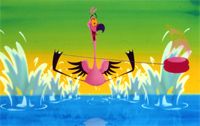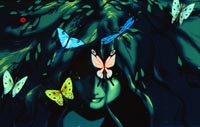
(That's IMAX, folks!)
© Disney Enterprises, Inc.
All rights reserved
® IMAX Corporation

|
Sometimes it takes 50 years (or more) before the sequel appears.
Luckily, that's not too often. When "Fantasia" appeared in 1941, it
wound up being an artistic success, but, unfortunately, a box-office
failure. This put a dampener on Uncle Walt's plans for turning out a
Fantastic Fantasia Feature every year thereafter. Having remained a
favorite of many throughout the years, the tables finally turned to the
right direction in 1991 when the video release of the feature proved a
financial success and opened the doors to continuing Mr. Disney's
original dream. A delight for endless children and adults (alike)
throughout the last half century, the 2nd edition has finally arrived; nine
years, nota bene, in the making. It is almost completely new, with the
one exception of the memorable "Sorcerer's Apprentice" starring the
beloved Mickey Mouse. Even this has been dusted off and enhanced. ENLARGED is the operative word
because "Fantasia 2000" is on IMAX.
Eleven cities throughout the world have been chosen by the Disney studios for the 4 month run of the movie at
IMAX theatres (until April 30th). A 35 mm print will undoubtedly follow some months later, but it is an
incredible experience on large format and well worth going the distance to see it. In Holland, it is on view at the
spectacular Rotterdam IMAX Cinema, where a section of wall had to be removed in order to install the new
equipment necessary for these screenings.
Seven spectacular new animated sequences are to be found here, all using incredible animated imagery,
exquisite classical music and state-of-the-art technology, of course. One would expect nothing less of Uncle
Walt. Obviously, nephew Roy (responsible for this project) is carrying on the tradition.
A Whale of a Time
Music: Ottorino Respighi's "Pines of Rome"
The greatest mammals known to man dominate the waters and move as gracefully as dancing fantasies.
Already seeming weightless, these creatures mystically take flight as a supernova explodes above a territory of
endless icebergs. The air appears as water and the water as air as they travel miraculously around, into, and
beyond, breaking all apparent boundaries. A mesmerizing introduction to unknown worlds.
Hirschfeld meets Gershwin
Music: George Gershwin's "Rhapsody in Blue"
The style of world famous caricaturist Al Hirschfeld is as synonymous to the world of New York society as
that of musician George Gershwin. Irretrievably connected with this metropolis, these two names, equal in
stature to each other, are married together in this portrayal of the Jazz Age in the 1930's. Hirschfeld (n.b.-
"Nina" can be found in this sequence on the top and bottom of Margaret's fur coat as well as on a toothpaste
tube) welcomed the homage paid to him in this animation by director Eric Goldberg.
A montage of Big Apple residents and city pulses, it focuses on 4 main characters: 1) Duke, a construction
worker who dreams of being a jazz musician, 2) John, who dreams, apparently unlike his wife, of having fun in
life, 3) Joe, an unemployed man who desperately continues on a crusade seeking work, and 4) Rachel, a inept
young student dragged to music lessons who would rather be spending time at home with her working parents.
This portrait of New York contains a world of personal problems that all seek resolution.
Influenced by Liszt, blues music and the sound of a train trip he once took to Boston, the composer (partially
improvising the as yet unfinished solo piano part) first played the piece at New York's Aeolian Hall on
February 12th, 1924. "Rhapsody in Blue," was an overnight success and has become known the world round
as well as being one of the most frequently played orchestral works written by an American. (Music lovers,
please note that George Gershwin (the cartoon version) makes an appearance at the piano (and that the
correct fingers are on the proper keys as he plays the notes.)
The finished film was screened for Mr. Hirschfeld just before his 96th birthday. His response was one of
elation: "I think they've done a remarkable job. It's incredible, the communication of the line through the
animation and what those animators have done under the direction of Mr. Goldberg. It's fantastic really, and
the animation is a creative thing in itself. I'm confined to a static piece of paper, but in film it's a completely
different creative process. I'm very pleased, flattered and impressed by what he's done with the lines. I don't
know how he did it. It's mysterious, like all art. The collaboration existed from his understanding what my
drawings were all about and he's translated them into animation that pleases me and I hope the audience to the
same extent." And further, "Walt Disney's original inception was the line and the movement of line to
communicate to a viewer. 'Rhapsody in Blue' shows that it still works. I'm surprised every few seconds as
another incident happens in the movie. It startles me and makes me realize how great animation is compared to
the straight static line. I wrote the review of 'Fantasia' in The Times back in 1940 and I thought it was
remarkable. I also knew George Gershwin when I was a teenager and he was a very young man. 'Rhapsody'
is very descriptive music and Mr. Goldberg has captured it beautifully on film."
C) Disney Enterprises, Inc.
All rights reserved
® IMAX Corporation

|
A Musical Fairy Tale
Music: Dmitri Shostakovich's "Piano Concerto #2, Allegro, Opus 102"
Hans Christian Andersen's tale of The Steadfast Tin Soldier is
beautifully choreographed to Shostakovich's music featuring archival
illustrations made by a Disney artist from the 1940's. The marriage of
these original figures, expanded by the use of CGI, to the concerto fit
practically hand-in-glove despite the fact that they were not originally
planned that way when the sketches were made some sixty years ago.
This piano concerto has many more explosive and energetic moments
than found among the darker passages of his more familiar work,
probably because the composer wrote this piece for his son's 19th birthday.
The Jack-in-the-Box is a
delightful villain whose immense size makes him all the more frightening as
he transforms from smiling toy into
terrifying monster (just as such creatures were in the fairy tales of old).
C) Disney Enterprises, Inc.
All rights reserved
® IMAX Corporation

|
Flamingos with Yo-Yos
Music: Camille Saint-Saens's "Les Carnival des Animaux, Finale"
Having often been used in the cinema, Saint-Saens' composition has
found yet another manifestation in the form of yo-yo playing flamingos.
Originally conceived by Disney story supervisor Joe Grant (who also
worked on the original "Fantasia") as yo-yo playing ostriches, the birds
of one feather gave way to another and the yo-yos got rolling. One
group looks down their beaks at a nonconformist bird. They
disapprove of his game playing, but he continues on his way,
performing tricks and creating utter chaos. The bright colors and
images are reminiscent of Disney's earlier "Alice in Wonderland" sequence containing the unforgettable game of
croquet. 3,000 hand painted cells were used in order to capture the appropriate tropical palette.
The Sorcerer's Apprentice
Music: Paul Dukas' "The Sorcerer's Apprentice"
A classic. Mickey Mouse casts his spell once again. Yensid lives.
Donald Duck
Music: Sir Edward Elgar's "Pomp and Circumstance - Marches 1,2,3, and 4"
Donald demands equal billing. He assists Noah on his ark to bombastic notes and with a little help from darling
Daisy.
C) Disney Enterprises, Inc.
All rights reserved
® IMAX Corporation

|
The Ultimate Finale: A Vision of Hope
Music: Igor Stravinsky's "Firebird Suite - 1919 version"
A lone Elk who reigns as monarch of the forest summons nature in the
form of a Sprite. After the beauty of springtime has been destroyed by
the Firebird from the engulfing volcano, the Sprite and the Elk tend to
the rebirth of the ravaged forest and the reincarnation of life. Butterflies
soar through the air once again and life has come full circle.
Each one of the sequences has been developed separately to facilitate
different approaches and, as a result, incorporates various moods and
colors.
Following the original concept, all animations follow music and do not include spoken text. 12 new stories have
been created which are divided by interludes with comments and commentaries made onscreen by a range of
well-known stars appearing as celebrity hosts for the segments, all of whom have had some tie to the Disney
Corporation in the past. They're pleasant to watch, and nowhere near as naff as stars sometimes can be,
making remarks during some Hollywood award ceremonies. Appearing in the feature are such notables as
Steve Martin, Bette Midler, Penn & Teller, Angela Lansbury and James Earl Jones; among the favorites is
Donald Duck. They are not an integral part of the whole, but they are agreeable enough not to become too
disturbing.
Stokowski's position in the original film is (with the exception of the maestro's appearance in Mickey M's
sequence - digitally remastered) usurped by acclaimed conductor James Levine, whose 28 year association
with the Metropolitan Opera has made him a familiar name to music lovers. Five recording sessions, beginning
in 1993 and taking place over the period of several years, were held at Chicago's Medinah Temple where
digital recordings were made in order to capture the acoustics of an authentic concert hall. Film composer
Bruce Broughton conducted the recording session for the "Rhapsody in Blue" sequence separately at a studio
in Los Angeles. Not only is the film breathtaking to behold, but also to listen to.
What a way to begin the new century. As Uncle Walt once said, "'Fantasia' is timeless. It may run 10, 20, or
30 years. It may run after I am gone. 'Fantasia' is an idea in itself." Well, folks, the idea is finally back.
(See also: IMAX)
© 1994-2006 The Green Hartnett
|

